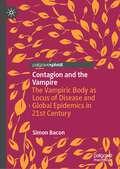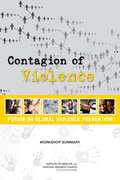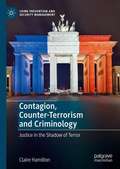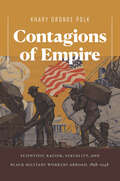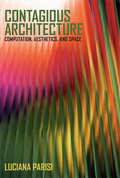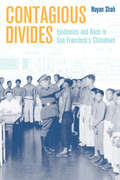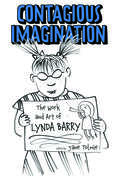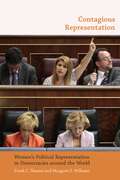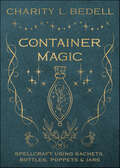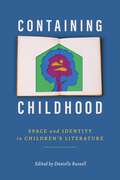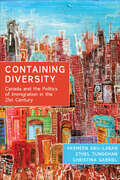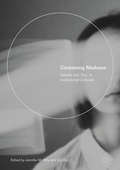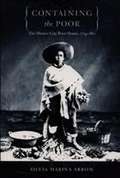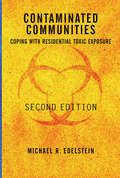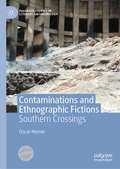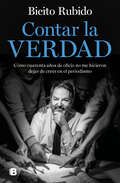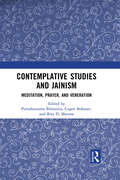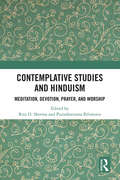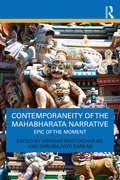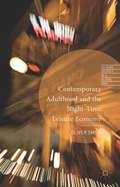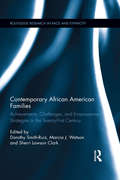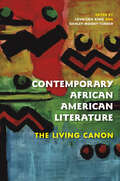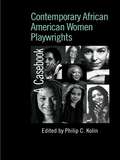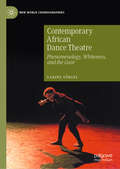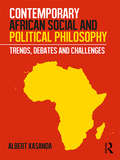- Table View
- List View
Contagion and the Vampire: The Vampiric Body as Locus of Disease and Global Epidemics in 21st Century
by Simon BaconThis book examines how the vampire has always been connected to ideas of infection, pollution and disease—even more so in the 21st century where it expresses the horrors of unseen and unstoppable disease and the foreboding and anxiety that accompany viral outbreaks and wider epidemics. Here the vampire gives physical form to the contagion and associated anxieties around the perceived causes and spread of disease, where it can take on many forms from animal to pestilential particulate matter, creeping shadows and even malignant weather systems. If blood is life, it is the body of the vampire that is death. This timely study looks at how and why the vampire continues to fulfil this function and posits that the true patient zero in the 21st century is no longer the dangerous, ancient, outsider from the East but is the undying monster that is Western culture itself.
Contagion of Violence
by Deepali M. PatelThe past 25 years have seen a major paradigm shift in the field of violence prevention, from the assumption that violence is inevitable to the recognition that violence is preventable. Part of this shift has occurred in thinking about why violence occurs, and where intervention points might lie. In exploring the occurrence of violence, researchers have recognized the tendency for violent acts to cluster, to spread from place to place, and to mutate from one type to another. Furthermore, violent acts are often preceded or followed by other violent acts. In the field of public health, such a process has also been seen in the infectious disease model, in which an agent or vector initiates a specific biological pathway leading to symptoms of disease and infectivity. The agent transmits from individual to individual, and levels of the disease in the population above the baseline constitute an epidemic. Although violence does not have a readily observable biological agent as an initiator, it can follow similar epidemiological pathways. On April 30-May 1, 2012, the Institute of Medicine (IOM) Forum on Global Violence Prevention convened a workshop to explore the contagious nature of violence. Part of the Forum's mandate is to engage in multisectoral, multidirectional dialogue that explores crosscutting, evidence-based approaches to violence prevention, and the Forum has convened four workshops to this point exploring various elements of violence prevention. The workshops are designed to examine such approaches from multiple perspectives and at multiple levels of society. In particular, the workshop on the contagion of violence focused on exploring the epidemiology of the contagion, describing possible processes and mechanisms by which violence is transmitted, examining how contextual factors mitigate or exacerbate the issue. Contagion of Violence: Workshop Summary covers the major topics that arose during the 2-day workshop. It is organized by important elements of the infectious disease model so as to present the contagion of violence in a larger context and in a more compelling and comprehensive way.
Contagion, Counter-Terrorism and Criminology: Justice in the Shadow of Terror (Crime Prevention and Security Management)
by Claire HamiltonThis book considers the impact of post 9/11 counter-terrorism laws outside of the counter-terrorism context, a process described here as ‘contagion’. It does so via a detailed empirical examination of the impact of counter-terrorism measures on the criminal justice systems of three selected EU countries with varying histories and experience of terrorism, namely, the UK, France and Poland. In particular, the book explores the synergistic relationship between counter-terrorism measures and control measures aimed at ‘ordinary’ crimes and asks what the implications are for the direction of travel of the criminal law in general. It probes the hegemonic power of terrorism and the securitisation agenda more broadly and discusses the implications for criminology as a discipline – does it, for example, have a role in social contestation of contagion? This book will be suitable for academics and students interested in political violence, terrorism and counterterrorism as well as practitioners and experts working in the area.
Contagions of Empire: Scientific Racism, Sexuality, and Black Military Workers Abroad, 1898–1948
by Khary Oronde PolkFrom 1898 onward, the expansion of American militarism and empire abroad increasingly relied on black labor, even as policy remained inflected both by scientific racism and by fears of contagion. Black men and women were mobilized for service in the Spanish-Cuban-American War under the War Department's belief that southern blacks carried an immunity against tropical diseases. Later, in World Wars I and II, black troops were stigmatized as members of a contagious "venereal race" and were subjected to experimental medical treatments meant to curtail their sexual desires. By turns feared as contagious and at other times valued for their immunity, black men and women played an important part in the U.S. military's conscription of racial, gender, and sexual difference, even as they exercised their embattled agency at home and abroad.By following the scientific, medical, an cultural history of African American enlistment through the archive of American militarism, this book traces the black subjects and agents of empire as they came into contact with a world globalized by warfare.
Contagious Architecture: Computation, Aesthetics, and Space (Technologies of Lived Abstraction)
by Luciana ParisiA proposal that algorithms are not simply instructions to be performed but thinking entities that construct digital spatio-temporalities.In Contagious Architecture, Luciana Parisi offers a philosophical inquiry into the status of the algorithm in architectural and interaction design. Her thesis is that algorithmic computation is not simply an abstract mathematical tool but constitutes a mode of thought in its own right, in that its operation extends into forms of abstraction that lie beyond direct human cognition and control. These include modes of infinity, contingency, and indeterminacy, as well as incomputable quantities underlying the iterative process of algorithmic processing. The main philosophical source for the project is Alfred North Whitehead, whose process philosophy is specifically designed to provide a vocabulary for “modes of thought” exhibiting various degrees of autonomy from human agency even as they are mobilized by it. Because algorithmic processing lies at the heart of the design practices now reshaping our world—from the physical spaces of our built environment to the networked spaces of digital culture—the nature of algorithmic thought is a topic of pressing importance that reraises questions of control and, ultimately, power. Contagious Architecture revisits cybernetic theories of control and information theory's notion of the incomputable in light of this rethinking of the role of algorithmic thought. Informed by recent debates in political and cultural theory around the changing landscape of power, it links the nature of abstraction to a new theory of power adequate to the complexities of the digital world.
Contagious Divides: Epidemics and Race in San Francisco’s Chinatown (American Crossroads #7)
by Nayan ShahContagious Divides charts the dynamic transformation of representations of Chinese immigrants from medical menace in the nineteenth century to model citizen in the mid-twentieth century. Examining the cultural politics of public health and Chinese immigration in San Francisco, this book looks at the history of racial formation in the U.S. by focusing on the development of public health bureaucracies. <P><P>Nayan Shah notes how the production of Chinese difference and white, heterosexual norms in public health policy affected social lives, politics, and cultural expression. Public health authorities depicted Chinese immigrants as filthy and diseased, as the carriers of such incurable afflictions as smallpox, syphilis, and bubonic plague. This resulted in the vociferous enforcement of sanitary regulations on the Chinese community. But the authorities did more than demonize the Chinese; they also marshaled civic resources that promoted sewer construction, vaccination programs, and public health management. Shah shows how Chinese Americans responded to health regulations and allegations with persuasive political speeches, lawsuits, boycotts, violent protests, and poems. <P><P> Chinese American activists drew upon public health strategies in their advocacy for health services and public housing. Adroitly employing discourses of race and health, these activists argued that Chinese Americans were worthy and deserving of sharing in the resources of American society.
Contagious Imagination: The Work and Art of Lynda Barry (Critical Approaches to Comics Artists Series)
by Glenn WillmottContributions by Frederick Luis Aldama, Melissa Burgess, Susan Kirtley, Rachel Luria, Ursula Murray Husted, Mark O’Connor, Allan Pero, Davida Pines, Tara Prescott-Johnson, Jane Tolmie, Rachel Trousdale, Elaine Claire Villacorta, and Glenn WillmottLynda Barry (b. 1956) is best known for her distinctive style and unique voice, first popularized in her underground weekly comic Ernie Pook’s Comeek. Since then, she has published prolifically, including numerous comics, illustrated novels, and nonfiction books exploring the creative process. Barry’s work is genre- and form-bending, often using collage to create what she calls “word with drawing” vignettes. Her art, imaginative and self-reflective, allows her to discuss gender, race, relationships, memory, and her personal, everyday lived experience. It is through this experience that Barry examines the creative process and offers to readers ways to record and examine their own lives. The essays in Contagious Imagination: The Work and Art of Lynda Barry, edited by Jane Tolmie, study the pedagogy of Barry’s work and its application academically and practically. Examining Barry’s career and work from the point of view of research-creation, Contagious Imagination applies Barry’s unique mixture of teaching, art, learning, and creativity to the very form of the volume, exploring Barry’s imaginative praxis and offering readers their own. With a foreword by Frederick Luis Aldama and an afterword by Glenn Willmott, this volume explores the impact of Barry’s work in and out of the classroom. Divided into four sections—Teaching and Learning, which focuses on critical pedagogy; Comics and Autobiography, which targets various practices of rememorying; Cruddy, a self-explanatory category that offers two extraordinary critical interventions into Barry criticism around a challenging text; and Research-Creation, which offers two creative, synthetic artistic pieces that embody and enact Barry’s own mixed academic and creative investments—this book offers numerous inroads into Barry’s idiosyncratic imagination and what it can teach us about ourselves.
Contagious Representation: Women’s Political Representation in Democracies around the World
by Frank C. Thames Margaret S. WilliamsWomen’s participation in parliaments, high courts, and executiveoffices worldwide has reached record high numbers, but thisglobal increase in women’s representation masks significant variationamong different democratic political systems. For example, inDecember of 2009, Rwanda’s legislature contained 56% women,while the U.S. Congress contained only about 17% and the JapaneseDiet had only 11%. Since 2000, only twenty-seven womenhave achieved executive office worldwide. Contagious Representationis a comprehensive look at women’s participation in all aspectsof public life in the main democratic political institutions—the executive,the judiciary, the legislature, and within political parties.Moving beyond studies of single countries and institutions, ContagiousRepresentation presents original data from 159 democraticcountries spanning 50 years, providing a comprehensive understandingof women in democracies worldwide. The first volume tooffer an analysis on all avenues for women’s participation for sucha lengthy time period, Contagious Representation examines notonly the causes of women’s representation in the main democraticpolitical institutions but also how women’s representation in oneinstitution affects the others. Each chapter contains case studiesand examples of the change in women’s participation over timefrom around the world. Thames and Williams definitively explainthe rise, decline, or stagnant levels of women’s political participation,considering how representation is contagious across politicalinstitutions and gaining a better understanding of what factors affectwomen’s political participation.
Container Magic: Spellcraft Using Sachets, Bottles, Poppets & Jars
by Charity L. Bedell100+ Spells for Bags, Jars, Sachets & MoreCapture the magic within using Charity L. Bedell's original workings rooted in Conjure, Hoodoo, European folk magic, and modern witchcraft. She lays out the basics for using containers and shares extensive resources, making it easy to work magic with whatever supplies you have on hand. This book teaches you how to choose the right container, fill it for specific purposes, and cleanse and dispose of materials. You'll discover packets and poppets for short-term goals, charm bags for money magic, and witch balls for long-term protection. Featuring herbal and crystal correspondences, incense and oil formulas, and more, this is the spellbook you've always wanted.
Containing Childhood: Space and Identity in Children’s Literature (Children's Literature Association Series)
by Danielle RussellContributions by Miranda A. Green-Barteet, Kathleen Kellett, Andrew McInnes, Joyce McPherson, Rebecca Mills, Cristina Rivera, Wendy Rountree, Danielle Russell, Anah-Jayne Samuelson, Sonya Sawyer Fritz, Andrew Trevarrow, and Richardine Woodall Home. School. Nature. The spaces children occupy, both physically and imaginatively, are never neutral. Instead, they carry social, cultural, and political histories that impose—or attempt to impose—behavioral expectations. Moreover, the spaces identified with childhood reflect and reveal adult expectations of where children “belong.” The essays in Containing Childhood: Space and Identity in Children’s Literature explore the multifaceted and dynamic nature of space, as well as the relationship between space and identity in children’s literature. Contributors to the volume address such questions as: What is the nature of that relationship? What happens to the spaces associated with childhood over time? How do children conceptualize and lay claim to their own spaces? The book features essays on popular and lesser-known children’s fiction from North America and Great Britain, including works like The Hate U Give, His Dark Materials, The Giver quartet, and Shadowshaper. Adopting a multidisciplinary approach in their analysis, contributors draw upon varied scholarly areas such as philosophy, race, class, and gender studies, among others. Without reducing the issues to any singular theory or perspective, each piece provides insight into specific treatments of space in specific periods of time, thereby affording scholars a greater appreciation of the diverse spatial patterns in children’s literature.
Containing Diversity: Canada and the Politics of Immigration in the 21st Century
by Ethel Tungohan Yasmeen Abu-Laban Christina GabrielAlthough Canada is known internationally as a leader among industrialized countries for inclusive practices towards immigrants and refugees, the twenty-first century has witnessed a rise in the number of refugees and temporary migrant workers who are often denied citizenship and may also experience detention and deportation. Containing Diversity examines to what extent Canada’s long-standing support for immigration, multiculturalism, and citizenship has shifted in favour of discourses, policies, and practices that "contain" diversity. This book reflects on how diversity is being "contained" through practices designed to insulate the Canadian settler-colonial state. In assessing the Canadian government’s policies towards refugees and asylum seekers, economic migrants, family-class migrants, temporary foreign workers, and multiculturalism, the authors show the various contradictory practices in effect. Containing Diversity reflects on policy changes, analysed alongside the resurgence of right-wing political ideology and the realities of the COVID-19 pandemic. Ultimately, Containing Diversity highlights the need for a re-imagining of new forms of solidarity that centre migrant and Indigenous justice.
Containing Madness: Gender and ‘Psy’ in Institutional Contexts
by Jennifer M. Kilty Erin DejThis collection explores the discursive production and treatment of mental distress as it is mediated by gender and race in different institutional contexts. Featuring analyses of the prison, the psychiatric hospital, immigration detention, and other locales, this book explores the multiple interlocking oppressions that result in the diagnosis and medical, psychological, and psychiatric treatment of individuals constituted as ‘mentally ill’ at various historical moments and across institutional spaces. Contributors unpack how feminine, masculine, and transgender bodies are made up as mentally ill/sick/deviant by way of biomedical and institutional knowledges and discourses and are intervened upon by different institutional and expert authorities.
Containing the Poor: The Mexico City Poor House, 1774–1871
by Silvia Marina ArromIn 1774 Mexico City leaders created the Mexico City Poor House--the centerpiece of a bold experiment intended to eliminate poverty and impose a new work ethic on former beggars by establishing a forcible internment policy for some and putting others to work. In Containing the Poor Silvia Marina Arrom tells the saga of this ill-fated plan, showing how the asylum functioned primarily to educate white orphans instead of suppressing mendicancy and exerting control over the multiracial community for whom it was designed. For a nation that had traditionally regarded the needy as having the undisputed right to receive alms and whose affluent citizens felt duty-bound to dispense them, the experiment was doomed from the start, explains Arrom. She uses deep archival research to reveal that--much to policymakers' dismay--the Poor House became an orphanage largely because the government had underestimated the embeddedness of this moral economy of begging. While tracing the course of an eventful century that also saw colonialism give way to republicanism in Mexico, Arrom links the Poor House's transformation with other societal factors as well, such as Mexican women's increasing impact on social welfare policies. With poverty, begging, and homelessness still rampant in much of Latin America today, this study of changing approaches to social welfare will be particularly valuable to student and scholars of Mexican and Latin American society and history, as well as those engaged in the study of social and welfare policy.
Contaminated Communities: Coping With Residential Toxic Exposure, Second Edition
by Michael EdelsteinPresents a unifying set of empirically based theories that seek to explain the experience of perceived toxic exposure for individuals, families, and communities. Impacts to lifestyle, lifescape, and emotion, as well as social and societal dynamics are explored.. Given the myriad fears and dangers associated with residential toxic exposure, it is surprising that until now no comprehensive examination of the social dynamics of exposure has been available. In Contaminated Communities, Michael R. Edelstein provides a foundation for understanding complex responses to incidents of toxic contamination-responses of the public, government agencies, members of the helping professions, and victims themselves. Drawing upon social psychological theory and an extensive survey of documented cases of toxic exposure, enlivened by excerpts drawn from more than a thousand interviews with victims, the author presents a candid and moving portrayal of the toxic victim's experience and the key stages in the course of toxic disaster. Of particular value is Edelstein's analysis of the effects of toxic exposure on life-style and on cognition, in which he explains how individuals' perceptions of themselves, their families, their community, the environment, and their government gradually change after exposure. The analysis provides both a descriptive and a theoretical framework for interpreting individual, family, community, and societal dynamics and their mutual influences and important insights into the culture of contamination. An outstanding example of "action research," this book seeks to improve our understanding of the threat of toxic disaster as a means of enhancing our ability to respond effectively.In the second edition to this groundbreaking text, the author updates and supplements the existing material with hundreds of new citations and an greatly expanded bibliography.
Contaminations and Ethnographic Fictions: Southern Crossings (Palgrave Studies in Literary Anthropology)
by Oscar HemerIn an unusual merging of academic and literary practices, this volume attempts to identify a form (or forms) that is congenial with the subject of interrogation: the world in transition, with South Africa as the main focal point. Approaching anthropology from the position of the literary writer, Oscar Hemer here takes the reader through a kaleidoscope of perspectives—a stream-of-consciousness understanding of “writing the city” of Johannesburg, embedding ethnography in subjectivity; a challenge to binaries both temporal and gendered in examining the growth of the IT metropolis Bangalore to a combusting mega-city; an auto-ethnographic interweaving of fictional reportage with a close-reading of anthropological and philosophical treatises, including Mary Douglas’s Purity and Danger and Edouard Glissant’s Poetics of Relation, among others—to interrogate themes of transition, identity, purity and variation in the Western Cape. As the form transcends boundaries to create a methodological hybrid, creolization comes to the fore as a theoretical concept and as cultural practice.
Contar la verdad
by Bieito RubidoUna confesión periodística tras abandonar la dirección de ABC. «Un libro esclarecedor y necesario que debería leer todo español deseoso de conocer de primera mano cómo se marca el pulso de su país».CARLOS HERRERA ¿Cómo se enfrenta el director de un periódico a las luchas y presiones para publicar o no una información que afecta al poder político y económico? ¿Quiénes son realmente y cómo se comportan en las distancias cortas el emérito rey Juan Carlos y el rey Felipe, José María Aznar, Mariano Rajoy o Pedro Sánchez? ¿Es posible hacer un periodismo honesto en una época en la que lo que más vende es el engaño? Bieito Rubido, uno de los periodistas más influyentes de nuestro país, decidió escribir este libro tras abandonar la dirección del diario ABC. Sus vivencias recorren en primera persona los últimos cuarenta años de la vida pública española y nos muestran un retrato veraz, en ocasiones sorprendente y lleno de anécdotas sobre los protagonistas de nuestra historia reciente. Estas páginas nos descubren los entresijos, misterios e intrigas del oficio y nos muestran –como a espectadores de una bulliciosa mañana repleta de noticias– lo que es, hoy en día, una redacción. Desde la crisis del Prestige hasta el 11M o, más recientemente, los inicios de la pandemia de COVID, Rubido nos habla sin tapujos de las tensiones a las que ha debido hacer frente como director de un gran medio, sin temor a contar con claridad cuándo y por quién fue a veces presionado para publicar o no una información.
Contemplative Studies & Jainism: Meditation, Prayer, and Veneration
by Purushottama Bilimoria Rita D. Sherma Cogen BohanecThis volume is one of the first wide-ranging academic surveys of the major types and categories of Jain praxis. It covers a breadth of scholarly viewpoints that reflect both the variegation in terms of spiritual practices within the Jain traditions as well as the Jain hermeneutical perspectives, which are employed in understanding its rich diversity. The volume illustrates a complex and nuanced understanding of the multifaceted category of Jain religious thought and practice. It offers a rare intrareligious dialogue within Jain traditions and at the same time, significantly broadens and enriches the field of Contemplative Studies to include an ancient, ascetic, non-theistic tradition. Meditation, yoga, ritual, prayer are common to all Indic spiritual traditions. By investigating these diverse, yet overlapping, categories one might obtain a sophisticated understanding of religious traditions that originally emerged in South Asia. Essays in this book demonstrate how these forms of praxis in Jainism, and the philosophies that anchor those practices, are interrelated, and when brought into dialogue, help to foster new tools for understanding a complex and variegated tradition such as Jain Dharma. This book will be useful to scholars and researchers of religious and theological studies, contemplative studies, Jain studies, Hindu studies, consciousness studies, Yoga studies, Indian philosophy and religion, sociology of religion, philosophy of religion, comparative religion, and South Asian studies, as well as general readers interested in the topic.
Contemplative Studies and Hinduism: Meditation, Devotion, Prayer, and Worship
by Rita D. Sherma; Purushottama BilimoriaThis book is one of the first wide-ranging academic surveys of the major types and categories of Hindu contemplative praxis. It explores diverse spiritual and religious practices within the Hindu traditions and Indic hermeneutical perspectives to understand the intricate culture of meditative communion and contemplation, devotion, spiritual formation, prayer, ritual, and worship. The volume extends and expands the conceptual reach of the fields of Contemplative Studies and Hindu Studies. The chapters in the volume cover themes in Hindu contemplative experience from various texts and traditions including classical Sāṃkhya and Patañjali Yoga, the Bhāgavata Purāṇa, the role of Sādhana in Advaita Vedānta, Śrīvidyā and the Śrīcakra, the body in Tantra, the semiotics and illocution of Gauḍīya Vaiṣṇava sādhana, mantra in Mīmāṃsā, Vaiṣṇava liturgy, as well as cross-cultural reflections and interreligious comparative contemplative praxis. The volume presents indigenous vocabulary and frameworks to examine categories and concerns particular to the Hindu contemplative traditions. It traces patterns that cut across Hindu traditions and systems and discusses contrasting methods of different theological/philosophical schools evincing a strong plurality in Hindu religious thought and practice. The volume provides intra-religious comparisons that reveal internal complexity, nuances, and a variety of contemplative states and transformative practices that exist under the rubric of Hindu practices of interiority and reflection. With key insights on forms and functions of the contemplative experience along with their theologies and philosophies, the volume suggests new hermeneutical directions that will advance the field of contemplative studies. This book will be useful to scholars and researchers of religious and theological studies, contemplative studies, Hindu studies, consciousness studies, yoga studies, Indian philosophy and religion, sociology of religion, philosophy of religion, comparative religion, and South Asian studies, as well as general readers interested in the topic.
Contemporaneity of the Mahabharata Narrative: Epic of the Moment
by Anirban Bhattacharjee and Dhrubajyoti SarkarNotwithstanding its renowned comprehensive narrative encapsulation of the Indic culture, the Mahabharata keeps on posing a challenge to its contemporary readers: how do we relate to something over two-millennia old in today’s context without freezing it in time? This volume looks at the problem from diverse periods and standpoints and shows us that this challenge is, in fact, a legacy of the Mahabharata and the responses to this challenge are what makes the text ever-contemporary to different readers of different times and positions.It traces the evolution of the Mahabharata from its inception in the fifth century BCE to twenty-first century, spanning classical Sanskrit tradition, Persian and Bengali adaptations, the Mahabharata as a serialized TV show to more recent graphic narratives. By attempting to analyse this diversity, this volume further delves into how the issues in the Mahabharata resonate across time, from the world of ancient sages to contemporary struggles of women. The essays in this book adopt a dual perspective to appreciate both the Mahabharata’s historical context, its exploration of war, heroes and heroines, gender, psychology, philosophy, and its implications for the future.This book will be of interest to scholars and researchers of Indian literature, ancient literature and philosophy, English literature, cultural studies, visual studies, gender studies, and translation studies.
Contemporary Adulthood and the Night-Time Economy
by Oliver SmithUnpicking the lives of dedicated drinkers, hedonists and adult consumers, Contemporary Adulthood and the Night-Time Economy examines the emergence of new forms of cultural and aesthetic attachment to alcohol and reconsiders the way we think about and use our city centres. The first generation to experience the new experiential markets of the night-time economy are now in their thirties and forties, but have been largely neglected in research on alcohol consumption and night-time leisure practices. While the general assumption appears to be that such individuals simply grow up and grow out of excessive alcohol consumption and adopt the identity of a respectable adult, Contemporary Adulthood and the Night-Time Economy highlights how the late night city centre continues to act as a significant draw and as a means of examining the relationship between consumer capitalism and the erosion of traditional adult identity. For committed consumers the night-time economy represents part of a powerful trend that is destabilising identity, cultivating narcissism and infantilising a generation.
Contemporary African American Families: Achievements, Challenges, and Empowerment Strategies in the Twenty-First Century (Routledge Research in Race and Ethnicity)
by Dorothy Smith-Ruiz Sherri Lawson Clark Marcia J. WatsonFor decades the black community has been perceived, both in the United States and around the world, as one which thinks alike, acts alike and lives alike - in poor and downtrodden environments. Following the persistent effects of the great recession and the American elections of 2008, now more than ever the political and socio-economic state of America is crying out for this deficient and prejudiced conception to be dispelled. Focusing primarily on black families in America, Contemporary African American Families updates empirical research by addressing various aspects including family formation, schooling, health and parenting. Exploring a wide class spectrum among African American families, this text also modernizes and subverts much of the research resulting from Moynihan’s 1965 report, which arguably misunderstood the lived experiences of black people during the movement from slavery to freedom in a Jim Crow society. A timely subversion of the myth that America is successfully in a post-racial era, this new anthology on the Black Family in America will appeal to advanced undergraduate students and research scholars interested in black studies, Africana studies, women and gender studies, sociology, political science, anthropology, criminal justice, education, psychology, public policy, healthy policy and social work.
Contemporary African American Literature: The Living Canon (Blacks in the Diaspora)
by Lovalerie King and Shirley Moody-TurnerEssays exploring contemporary black fiction and examining important issues in current African American literary studies.In this volume, Lovalerie King and Shirley Moody-Turner have compiled a collection of essays that offer access to some of the most innovative contemporary black fiction while addressing important issues in current African American literary studies. Distinguished scholars Houston Baker, Trudier Harris, Darryl Dickson-Carr, and Maryemma Graham join writers and younger scholars to explore the work of Toni Morrison, Edward P. Jones, Trey Ellis, Paul Beatty, Mat Johnson, Kyle Baker, Danzy Senna, Nikki Turner, and many others. The collection is bracketed by a foreword by novelist and graphic artist Mat Johnson, one of the most exciting and innovative contemporary African American writers, and an afterword by Alice Randall, author of the controversial parody The Wind Done Gone. Together, King and Moody-Turner make the case that diversity, innovation, and canon expansion are essential to maintaining the vitality of African American literary studies.“A compelling collection of essays on the ongoing relevance of African American literature to our collective understanding of American history, society, and culture. Featuring a wide array of writers from all corners of the literary academy, the book will have national appeal and offer strategies for teaching African American literature in colleges and universities across the country.” —Gene Jarrett, Boston University“[This book describes] a fruitful tension that brings scholars of major reputation together with newly emerging critics to explore the full range of literary activities that have flourished in the post-Civil Rights era. Notable are such popular influences as hip-hop music and Oprah Winfrey’s Book Club.” —American Literary Scholarship, 2013
Contemporary African American Women Playwrights: A Casebook (Casebooks on Modern Dramatists)
by Philip C. Kolin'The impressive array of scholars gathered in this collection, all experts in the field, read the plays with nuance and situate them deftly within their cultural and historical contexts. Scholars of contemporary theater and drama and of African American literature will find value in this engaging collection.' – Choice 'For students and scholars of American theatre and drama generally and African American theatre and drama most particularly, this is an extremely valuable critical source.' – Harry Elam, Stanford University, USA In the last fifty years, American and World theatre has been challenged and enriched by the rise to prominence of numerous female African American dramatists. Contemporary African American Women Playwrights is the first critical volume to explore the contexts and influences of these writers, and their exploration of black history and identity through a wealth of diverse, courageous and visionary dramas. Kolin compiles a wealth of new essays, comprising: Yale scholar David Krasner on the dramatic legacy of Lorraine Hansberry, Zora Neale Hurston, Marita Bonner and Georgia Douglas Johnson individual chapters devoted to: Alice Childress, Sonia Sanchez, Adrienne Kennedy, Ntozake Shange, Pearl Cleage, Aishah Rahman, Glenda Dickerson, Anna Deavere Smith and Suzan Lori-Parks an essay and accompanying interview with Lynn Nottage comprehensive discussion of attendant theatrical forms, from choreopoems and surrealistic plays, to documentary theatre and civil rights dramas, and their use in challenging racial and gender hierarchies. Contributors: Brandi Wilkins Catanese, Soyica Diggs, James Fisher, Freda Scott Giles, Joan Wylie Hall, Philip C. Kolin, David Krasner, Sandra G. Shannon, Debby Thompson, Beth Turner and Jacqueline Wood.
Contemporary African Dance Theatre: Phenomenology, Whiteness, and the Gaze (New World Choreographies)
by Sabine SörgelThis book is the first to consider contemporary African dance theatre aesthetics in the context of phenomenology, whiteness, and the gaze. Rather than a discussion of African dance per se, the author challenges hegemonic perceptions of contemporary African dance theatre to interrogate the extent to which white supremacy and privilege weave through capitalist necropolitics and determine our perception of contemporary African dance theatre today. Multiple aesthetic strategies are discussed throughout the book to account for the affective experience of ‘un-suturing’ that touches white spectatorship and colonial guilt at their core. The critical analysis covers a broad range of dance choreography by artists from the Democratic Republic of Congo, Ivory Coast, South Africa, Canada, Europe, and the US as they travel, create, and show their works internationally to global audiences to contest racial divides and white supremacist politics.
Contemporary African Social and Political Philosophy: Trends, Debates and Challenges
by Albert KasandaThis book explores what constitutes contemporary African social and political philosophy with regard to its meaning, aims, sources, and relevance for today’s Africa. Kasanda denounces conventional approaches considering these either as a subcategory of general philosophy or as the ideological attempts of individual African leaders and professional philosophers, such as Nkrumah, Nyerere, Senghor, Fanon, Hountondji and Towa. On the contrary, Kasanda defines contemporary African social and political philosophy as an inclusive reflection of African communities with regard to power and equitable modes of social and political organization in order to promote human excellence for everyone. This perspective also includes the criticism of social and political concepts in use within African communities. The author postulates that contemporary African social and political philosophy relies on the legacy of precolonial African societies, as well as on the contribution of the diaspora throughout the world. Contemporary African social and political philosophy is rooted in the daily lives of African people, and it expresses itself through multiple modalities including, for example, art, religion, literature, music and the policy of urbanization of African cities. This book sheds new light on debates concerning topics such as ethnophilosophy, negritude, pan-Africanism, democracy, African civil society, African cultures, and globalization. It aims to ward off the lethargy that strikes African social and political philosophy, taking a renewed and critical approach.
